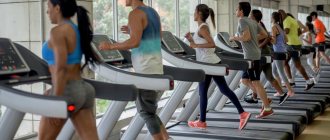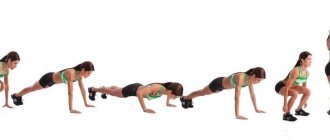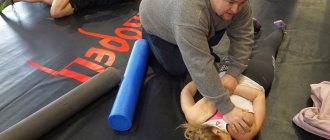Many people have heard about the benefits of interval running for weight loss, but not everyone knows what it is. Interval running involves alternating periods of intense exercise and periods of dynamic rest. Moreover, you can run both in nature and in urban areas and on a treadmill. This is a great way to lose weight and get healthier, provided, of course, that you know how to run correctly.
What is interval running
Interval running is one of the best solutions for losing weight and developing endurance.
The point is to alternate load modes: you run one section of the route at a calm pace, and on the next you speed up as much as possible. This is how not only professional athletes train in preparation for marathons and competitions, but also amateurs. “Interval running is alternating the intensity of the load while running (walking). At different time intervals, with different variables, such as distance, time or heart rate, says Yaroslav Khokhlov, personal trainer for X-Fit gyms in Russia. — The load is selected individually and can vary significantly depending on the person’s task. This type of load can also be applied to other cyclic continuous movements, such as swimming, cycling, rowing.”
Preparation
Interval running for weight loss begins with preparation and warm-up. The effectiveness of the entire workout depends on the body’s readiness for stress. The purpose of the warm-up is to tune the body, increase the tone of the nervous system, warm up the muscles, and prevent injuries . Each exercise before interval training should be repeated 6-8 times at an average pace without jerking:
- Head rotation.
- Rotation of arms to shoulders.
- Jerks with arms while turning the body left and right.
- Circular rotation of the pelvis to the right and left.
- Tilts to the right, left leg, to the center.
- Circular rotations of the hips.
- Alternately pulling the thigh towards the body while grasping the knee with both hands.
- Deep lunges forward, feeling the stretch in the back of the thigh.
- Side lunges, hand-supported rolls.
- Rotation of the ankle joint.
Why do you need interval running?
Interval running has a number of advantages over simply running at a constant speed. Moreover, both from the point of view of sports achievements and from the point of view of fitness.
- This is the most effective way to learn to run faster, improving your performance at any distance - from the 60m sprint to the marathon. Depending on the distance you are training for, the length of the intervals and speed will vary.
- This is one of the ways to learn to run in principle. “Due to a properly selected load, using alternating walking and acceleration (running), a person can learn to cover short distances at a faster speed, which will help adapt to running as a physical activity,” says Yaroslav Khokhlov.
- Interval running burns more calories than regular running. During accelerations (intensive intervals), energy consumption almost doubles, while during the rest stage it does not immediately decrease.
- Unusual load (acceleration) is a certain stress for muscles and other body systems. It is not large enough to cause harm. But after such a workout, the muscles intensively spend calories for recovery, drawing them from fat reserves. In other words, interval running speeds up your metabolism.
- This workout allows you to lose fat while maintaining muscle mass and even increasing it a little. Sprint intervals (accelerations over segments from 50 m to 400 m) are especially good for this.
- Interval running increases the level of VO2 max, maximum oxygen consumption. “MOC is a very good biomarker of health and one of its key indicators, ” says Svetlana Uvarova, coach of the Running Community . — People with high BMD can avoid type 2 diabetes and reduce the risk of heart disease, cancer, obesity and other diseases. There is scientific research that suggests that well-chosen interval training improves glycemic control.”
- Such training strengthens muscles well. “Interval running trains not only the cardio and respiratory systems, but also the muscular corset, forcing it to adapt to acceleration,” adds Yaroslav Khokhlov.
Useful tips
To make your interval running regimen for burning fat as effective as possible, follow these recommendations:
- Regardless of the time and intensity of the workout, do not forget about warming up. It will help the body as a whole and muscles prepare for upcoming loads, reduce the risk of injury, and prevent muscle pain.
- Ideal for running in parks and forested areas. There is a lot of oxygen, which is necessary for the body under stress. Secondly, more difficult terrain increases the effectiveness of training.
- Be sure to wear comfortable shoes, which will help reduce stress on your joints.
- As you train, remember that slow sections are just as important as fast ones. At this time, you must allow the body to recover to the extent that it will allow you to withstand the next section.
- During training, watch your breathing. If it is correct, you will be less tired. Breathe slowly and darkly, inhale through your nose and exhale through your mouth. Make sure that during slow sections your breathing is fully restored.
Provided the technique is correct and there are no contraindications, interval running will only bring benefits. After just a few workouts, you will notice changes for the better in terms of physical fitness, increased endurance and speed. But if you feel bad during exercise, do not exhaust yourself and adjust the load. To relax, you should try MFR training.
Who is interval running suitable for?
Accelerations are a serious strain on the heart and blood vessels, as well as muscles and joints. Therefore, interval running is not recommended for beginners. You can switch to it no earlier than six months of regular jogging. There is another criterion: before practicing acceleration, your comfortable speed for a 5-10 km run should be at least 6:30/km - “six thirty per kilometer” (
that is, you should run 1 kilometer in 6 minutes and 30 seconds, no slower)
.
If the above sounds like you, then interval running will be very useful for you in two cases:
1. If you need to learn to run faster. In this case, you can practice quite often. “It all depends on how you feel, since interval training is high-intensity and takes a lot of energy. It is important that the body has time to recover, so it is advisable to have at least 1 day of rest and recovery between workouts. Twice a week will be enough,” says Svetlana Uvarova.
2. If you want to “sculpt” your figure, make it more prominent (in this case, you will also have to watch your diet: reduce the calorie intake by 200-300 kcal per day and increase the amount of protein to 1.8-2 g per kilogram of body weight ).
This type of training should be done once every 1-2 weeks; on the remaining days, practice calm, steady running or practice other types of fitness.
Because you run faster during an interval session, it will be slightly shorter than a standard run. For those who are just getting acquainted with interval running, the standard time is 30-40 minutes, while speed work should take 20-25 minutes. You can lengthen your workout by running slowly during the cool-down. It will be possible to increase the distance and the number of speed intervals only when the body gets used to it, that is, not earlier than in 2-3 months.
Be careful. “If you take too intense accelerations in the interval, the risk of injuring the articular-ligamentous apparatus increases. You need to listen to the body and if discomfort occurs, give the body a rest and contact a specialist,” notes Yaroslav Khokhlov.
Tip #4 – Consume no more than 2,200 calories per day
It happens that after hard training the weight does not come off. Doubts arise as to whether running helps in the fight against extra pounds. Jogging only helps if the athlete follows the basic rule of losing weight: spend more energy than you consume. Any workout works well only in combination with a healthy diet. Therefore, it is important not only to know how to run correctly, but also to provide yourself with a varied diet high in carbohydrates and proteins. The norm for those losing weight is 1800-2200 kcal per day. A man needs 2.5 g of protein, 1 g of fat, 3-4 g of complex carbohydrates per 1 kg of weight; for women the norms are the same, only protein consumption is reduced to 1.5-2 g per day. This must be taken into account.
Eliminate fast food, fried foods, buns and sweets. The girls' favorite delicacy is candy, which can be replaced with honey, and a white loaf can be replaced with grain bread. Before you eat something, make sure whether this product is healthy for your figure. For example, one Big Mac contains 510 calories. And in order to burn them, you have to run 8 kilometers.
The diet should be dominated by slow carbohydrates (buckwheat porridge, oatmeal, brown rice), vegetables and fruits. Eat 5 times a day, in small portions - this is the key to a healthy diet. There are foods that help you lose weight:
• ginger – speeds up metabolism; • white cabbage – cleanses of toxins; • cucumbers – have a diuretic (diuretic) effect; • cinnamon – reduces sugar levels, which prevents the accumulation of fats; • grapefruit – “burns” fats; • green tea – improves metabolism; • almonds are an excellent way to satisfy hunger; • apples – normalize intestinal function.
Include these foods in your diet, and the weight loss process will go faster. In the table you can see the menu options:
| First breakfast | Lunch | Dinner | Afternoon snack | Dinner |
| Buckwheat | Kefir | Chicken soup, stewed vegetables and steamed white fish | Dried fruits, almonds | Stuffed peppers |
| Muesli with low-fat yogurt | Apple or orange | Vegetable soup, boiled chicken breast with rice | Kefir | Boiled fish with soy sauce, fresh cabbage salad |
| Hard-boiled egg, glass of kefir | Ryazhenka, dried fruits | Borscht, boiled tongue, cucumber salad | Apple | Oven baked vegetables |
| Fruit smoothie | Almonds and prunes | Ukha, stewed cabbage with meatballs. | Grapefruit | Baked eggplant or zucchini with cheese |
| 2 breads with low-fat cheese | Yogurt | Fresh cabbage soup, baked apple with ginger and cottage cheese | Orange | Steamed chicken cutlets, buckwheat |
Do not run immediately after eating or on an empty stomach. If you exercise in the morning, have breakfast an hour and a half before jogging; if in the afternoon or evening, then you can run two hours after eating. Morning is the best time for sports. During running, metabolic processes are launched in the body, hormones of happiness are produced, so you feel cheerful and energetic all day long.
When playing sports, you need to follow the drinking regime, because... During running, the body loses a lot of fluid. Drink at least 2 liters of clean water without gas per day, 400 ml of which should be drunk 1 hour before training. At the same time, you cannot drink a lot during class, maximum 150 ml every 20 minutes. After a run, don’t rush to quench your thirst, no matter how strong it is. Allow your body to come to its senses, wait until your pulse and breathing normalize.
For whom interval running is not suitable?
There are quite a lot of restrictions, because this is a significant load. “Contraindications for interval running are almost the same as for any intense physical activity: diseases of the cardiovascular system, injuries to the musculoskeletal system, problems with the spine and excess weight,” says Yaroslav Khokhlov.
Excess weight of more than 7 kg, cardiovascular diseases, muscle injuries, spinal diseases, exacerbation of arthrosis and osteochondrosis, even flat feet are a reason to postpone such training until better times or even forget about it altogether.
Contraindications
Interval training puts a lot of stress on the body. Therefore, they are not suitable for everyone. Contraindications to such activities are:
- heart diseases;
- high pressure;
- joint problems;
- large excess weight:
- low level of physical fitness.
Thus, only healthy people can do interval running. Beginners should put these activities aside and run regularly at a moderate pace for several months.
The principles of interval running
We start with a traditional warm-up (slow running) for 5-15 minutes. Then we begin to alternate intervals. In running they are counted in two ways.
By distance.
Suitable for those who run in a stadium or in a small circle with a certain length, as well as those who have a GPS heart rate monitor or an application on their phone. The training in this case might look like this:
- warm-up;
- acceleration - 1 lap, rest - 2 laps;
- acceleration - 2 laps, rest - 1 lap;
- acceleration - 2 laps, rest - 2 laps;
- acceleration - 1 lap, rest - 2 laps;
- hitch.
If the distance is known (considering that the length of the treadmill in a standard stadium is 400 m, and in a school one - from 230 to 350 m), then the following lesson option is possible:
- warm-up;
- acceleration - 400 m, rest - 800 m;
- acceleration - 800 m, rest - 400 m;
- acceleration - 800 m, rest - 800 m;
- acceleration - 400 m, rest - 800 m;
- hitch.
Please note, this is the same training, in the second case, scheduled for a standard 400 m stadium. Moreover, the alternation of “1 lap - 2 laps” is completely optional. Each interval can have a different number of laps: say, acceleration is 3 laps, and rest is only 1. This is determined by the coach depending on your level of training and goals.
By time. This is convenient for those who run around the park with a watch, but have no idea about the length of the route and don’t want to bother with measurements. In general, the training is then built according to the same scheme, but instead of meters, minutes or seconds are counted.
The workout might look like this:
- warm-up;
- acceleration - 1 minute, rest - 2 minutes;
- acceleration - 2 minutes, rest - 3 minutes;
- acceleration - 3 minutes, rest - 3 minutes;
- acceleration - 2 minutes, rest - 1 minute;
- acceleration - 1 minute, rest - 1 minute;
- hitch.
In all the examples, if you notice, the training is built on the principle of a pyramid: accelerations lengthen towards the middle and shorten towards the end of the lesson. The duration of rest also changes accordingly. In the middle of the workout, the rest can be the same time as the acceleration, or shorter. The last option is for very advanced athletes; we do not offer this to you.
Interval running for those who don't like to count
To complete the picture, we should mention another type of interval running - fartlek.
(translated from Swedish as “playing with speed”). For this type of training, no programs are prescribed: you decide for yourself that you will do 5, 10, or as many accelerations as you like. When your soul asks, you speed up; when you get bored, you slow down and rest.
But fartlek has its own nuances.
- It is not suitable for the lazy and those who find it difficult to force themselves to accelerate without a clear training plan.
- Inexperienced runners may not calculate their strength and push themselves at the very first accelerations so that the training ends as soon as it begins.
- Good for running in areas with lots of uphills and downhills. An interval program written down by minutes or meters may not be suitable: you need to rest, and this is when you get up. We need to speed up, but we don’t have the strength to do it uphill. Fartlek allows you to choose where to accelerate and where to rest.
Now that everything is clear with the theory, we bring to your attention two interval running programs. One of them is designed for less experienced runners, so the speed is not indicated. An indicator that you have really accelerated is your pulse, and for those who do not have a heart rate monitor, physical sensations (the table indicates which ones). The second program is for more advanced ones, so the load criteria are pulse and/or speed. Both programs can be used both outdoors and on a treadmill in the gym.
The essence of the method
The basic principle of interval running is the alternation of segments covered at maximum acceleration and periods at an easy pace or even complete rest.
You can run intervals both on a machine and in the fresh air, choosing routes with high-quality, smooth surfaces. There are no additional requirements for equipment: it is enough to have a comfortable uniform that can wick away moisture and good running shoes. Before training, you should not take fat burners based on caffeine or other stimulants, so as not to increase your heart rate and blood pressure to dangerous levels. You should also avoid sports drinks high in fast carbohydrates and opt for electrolyte liquids. After class, you should not go to the bathhouse or sauna, but a cold shower, on the contrary, will enhance the effect.
Interval running for beginners
Interval distances are indicated in meters and minutes, optional. Use the first or second option, but not both!
The total length of the run without a cool-down is 4 km, of which 1.2 km is a fast run (if you run on time, the distance will be slightly different). If you don’t have the strength to run during rest intervals, go to fast walking, and be sure to move your arms as if you were running, and don’t lower them.
Training program No. 1:
- warm-up 800 m (or 10 min.);
- 8 cycles: acceleration 150 m (or 1 min.), rest 150 m (or 1 min.), acceleration 150 m (or 1 min.);
- cool down 600 m (or 8 min.).
Training program No. 2:
- warm-up 800 m (or 10 min.);
- 2 accelerations of 200 m after a rest of 400 m (or 1 minute after a rest of 3 minutes);
- 1 acceleration 400 m after a rest of 400 m (or 2 minutes after a rest of 3 minutes);
- 2 accelerations of 200 m after a rest of 400 m (or 1 minute after a rest of 3 minutes);
- cool down 5-10 min.
Interval running for experienced
Everything that was written as an explanation for the previous workout is also suitable for this one. The total length of the run without a cool-down is 5.8 km, of which 2.8 km is fast running (if you run on time, the distance will be slightly different). It is suitable for those with at least 1 year of running experience.
Training program:
- warm-up 1 km (or about 10 minutes);
- 1 acceleration 400 m, rest 400 m (or 3 min., rest 3 min.);
- 1 acceleration 600 m, rest 400 m (or 3 min., rest 3 min.);
- 1 acceleration 800 m, rest 400 m (or 4 min., rest 3 min.);
- 1 acceleration 600 m, rest 400 m (or 3 min., rest 3 min.);
- 1 acceleration 400 m, rest 400 m (or 3 min., rest 3 min.);
- cool down 10-15 min.
Pay attention to your well-being, monitor your sensations so as not to push yourself and harm your cardiovascular system, muscles, ligaments and desire to continue training.
Pilates exercises for runners
These few movements will help fans of interval running: they will strengthen the abdominal and leg muscles, and also make the connections more elastic. Do them 2-3 times a week.
"Scissors"
Lie on your back, bend your elbows and place your hands on the back of your head. Smoothly lift your legs up to a right angle, stretching your toes. As you exhale, twist your body to the right, trying to reach your left elbow to your right knee. At the same time, lower your left leg down. Then return to the center and do the same in the other direction. This will amount to one repetition. Perform 12-15 of these repetitions
.
Benefits for weight loss
With the right approach to your diet, running intervals, you can achieve impressive results in losing weight. There are cases where in just one week people lost up to 1 kilogram of excess weight. Changing the intensity of physical activity has a stressful effect on the body, due to which metabolism accelerates. Metabolism accelerates during the fast pace phase and slows down during the dynamic rest phase. But the trick and uniqueness of this exercise is that the time of the slow running phase is not enough for the metabolic rate to return to its usual limits. Thus, the fat burning process actively occurs throughout the entire workout.











